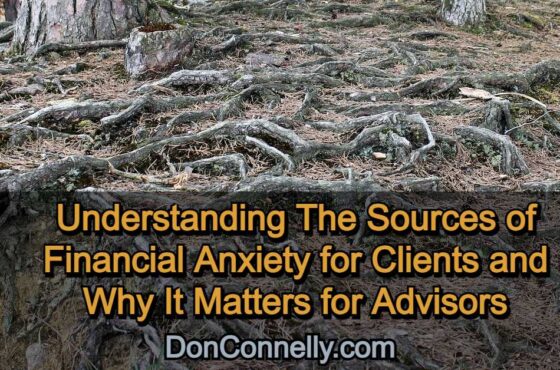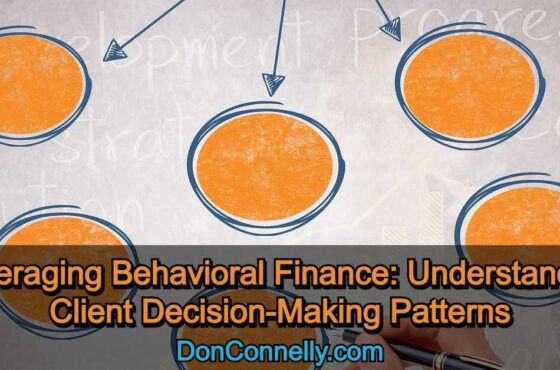The Art of Active Listening in Financial Advising: Building Trust and Uncovering Client Goals Beyond the Numbers
 We’ve devoted a lot of space here to discussing the concept of “active listening.” Why? Because it’s essential for connecting with clients on a more meaningful level. Beyond merely listening, active listening is an immersive, empathetic approach that enables you to pick up unspoken cues, explore clients’ deeper motivation, and get to the crucial “why.” Active listening is critical to moving clients to take action.
We’ve devoted a lot of space here to discussing the concept of “active listening.” Why? Because it’s essential for connecting with clients on a more meaningful level. Beyond merely listening, active listening is an immersive, empathetic approach that enables you to pick up unspoken cues, explore clients’ deeper motivation, and get to the crucial “why.” Active listening is critical to moving clients to take action.
Advisors who master active listening are able to transform the advisor-client relationship to understand and anticipate their client’s needs beyond the surface of financial data and gain insight into what truly matters to clients.
Listening beyond numbers
Most financial advisors are comfortable with numbers—gathering, crunching, and analyzing them. While data is crucial for developing a sound financial plan, they hardly capture the complete picture. Without active listening, it’s difficult to understand the “why” behind the numbers—why clients might prioritize certain goals over others, why they may be risk-averse or aggressive, or why they feel uneasy about financial decisions. In other words, active listening uncovers the real reason why a client will act on your advice.
For instance, a client might initially express interest in early retirement. But, by actively listening, you may learn their true goal is to spend more time with family or pursue personal passions. In essence, your client doesn’t want to buy a retirement solution; they want to buy more time to spend with their family and personal passions. This nuanced understanding of the client’s motivations can shape a strategy that aligns better with their long-term aspirations.
By focusing on the reasons behind financial choices, you’re better equipped to provide solutions that resonate deeply with clients, building a strong, trust-based relationship. When you can tune in to both their spoken words and underlying emotions, clients feel seen and understood, fostering a level of trust that financial metrics alone cannot achieve.
Practical techniques for active listening
Active listening is more than just a communication skill—although there are techniques you can use to develop the skill. However, it also requires developing a high level of sensitivity to uncover non-verbal cues, hidden anxieties, and unstated priorities.
Here are the critical techniques to master to become a highly effective active listener:
#1. Mirroring language
When you mirror a client’s language, it signals that you’re fully engaged in the conversation. By repeating key phrases or words, you show that you are not only listening but also validating the client’s feelings and concerns. For instance, if a client mentions feeling “uncertain” about their retirement savings, mirroring this term encourages them to elaborate, leading to a deeper discussion about their financial anxieties.
#2. Summarizing and paraphrasing
Summarizing helps clarify the client’s main points, showing them that you have a solid grasp of their priorities. For example, you might say, “It sounds like securing your family’s future is your main concern.” This technique allows clients to correct or clarify points, ensuring that advisors are on the right track in understanding their goals.
#3. Asking open-ended questions
Open-ended questions encourage clients to share more details, creating a more transparent dialogue. Instead of asking, “Are you comfortable with your current savings?” an advisor might ask, “What are your thoughts on where you’d like to be financially in the next ten years?” Such questions provide a window into the client’s long-term perspective, inviting them to express goals and concerns they may not have initially disclosed.
#4. Observing non-verbal cues
Body language, tone of voice, and facial expressions reveal much about a client’s comfort level and underlying feelings. If you notice a client’s hesitation or shift in tone when discussing a particular investment strategy, you can use this as a cue to delve deeper. A simple, “I noticed you seemed unsure when we discussed this—would you like to go over any aspects again?” can invite further dialogue, allowing advisors to address unstated worries or reservations.
By practicing and mastering these techniques, you can enhance your understanding of each client’s unique circumstances and create an open environment where clients can feel safe sharing their true feelings and objectives.
Case study example
Consider a scenario where a couple initially presents a conservative investment stance. Through actively listening, the advisor discovers that their hesitation comes from previous financial loss experienced during an economic downturn. This deeper insight allows the advisor to address those concerns empathetically, providing reassurance and helping the couple find a balanced strategy that mitigates risk without compromising their financial growth. In this case, active listening brought to light hidden concerns, enabling the advisor to provide tailored guidance that wouldn’t have been possible if they had only focused on the numbers.
Outcome: Loyalty and long-term relationships
Active listening is a powerful tool for financial advisors seeking to deepen client relationships and uncover insights beyond financial data. By focusing on clients’ motivations, anxieties, and unspoken aspirations, you can tailor strategies that truly resonate. In doing so, they enhance their client’s financial well-being and build a foundation of loyalty that drives long-term success. For advisors, the art of active listening is both a pathway to better service and a strategic advantage in creating lasting, impactful relationships.
Watch this 3-minute video to learn how our 24-step training program can help you ignite your performance and take your business to the next level!
See program details and enroll today!
Available as a self-paced program (always open) or as a 12-week coaching program (open only a couple of times a year), this training will change the way you view your practice and will give you an enormous advantage over your competition. Select your format and enroll now!



